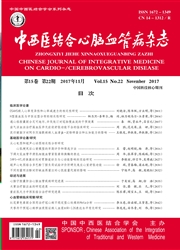

 中文摘要:
中文摘要:
目的将掌握症候群模式特征并且为心脏的症候群 X (CSX ) 探索繁体中文药(TCM ) 的有效治疗方法。TCM 症候群特征被掌握的方法和 TCM 干预节目被临床的调查为 CSX 病人的 TCM 症候群模式特征决定。然后,为 CSX 的 TCM 干预上的临床的功效研究通过使随机化的控制试用被执行。结果 CSX 是有胸疼痛和胸的主要表明的临床的症候群不通风,和 Qi 停滞,痰保留和血壅滞是 CSX 的基本症状。作为结果,调整 Qi,与一些西方的药综合的放松胸、激活血的治疗为治疗被采用。 调整Qi 的效果,放松胸、激活血的治疗罐头减少咽峡炎的频率和学位,改进症状并且行使病人的忍耐,禁止脉管的墙的煽动性的反应并且保护脉管的 endothelial 房间的功能,它独自比简单、常规的西方的药的好。好效果为 CSX 在中国、西方的药的集成被完成的结论。治疗是值钱的在临床的实践进一步被使用。在另一方面,长期的更多和有大样品的控制研究仍然是的 randomised 要求了进一步决定治疗的临床的功效和安全。
 英文摘要:
英文摘要:
OBJECTIVE: To master the syndrome patterns char- acteristics and explore the effective therapy meth- ods of Traditional Chinese Medicine (TCM) for cardi- ac syndrome X (CSX). METHODS: The TCM syndrome characteristics were mastered and the TCM intervention pro- grams were determined by clinical investigations for TCM syndrome patterns characteristics of CSX patients. Then, the clinical efficacy studies on TCM intervention for CSX were carried out through ran- domized controlled trials. RESULTS: CSX is a clinical syndrome with the main manifestations of chest pain and chest stuffiness, and Qi stagnation, phlegm retention and blood sta- sis are the basic symptoms of CSX. As a result, the Qi-regulating, chest-relaxing and blood-activatingtherapy integrated with some Western Medicines was adopted for treatment. The effect of Qi-regulat- ing, chest-relaxing and blood-activating therapy can reduce the frequency and degree of angina, im- prove the symptoms and exercise the tolerance of patients, inhibit the inflammatory response of vas- cular walls and protect the function of vascular en- dothelial cells, which is better than that of the sim- ple and conventional Western Medicine alone. CONCLUSION: A good effect was achieved in the integration of Chinese and Western Medicines for CSX. The therapy is worthy to be applied further in clinical practice. On the other hand, more long-term and randomised controlled studies with large samples are still required to further deter- mine the clinical efficacy and safety of the therapy.
 同期刊论文项目
同期刊论文项目
 同项目期刊论文
同项目期刊论文
 期刊信息
期刊信息
